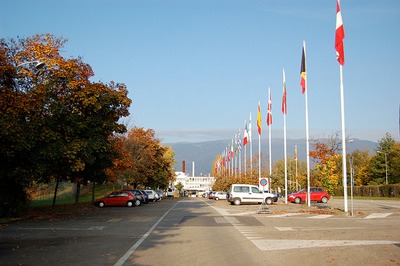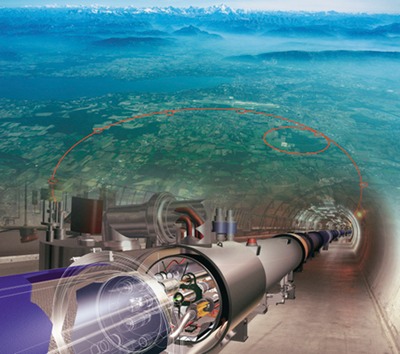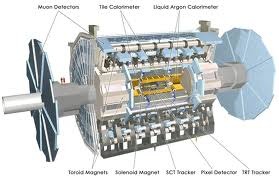What is particle physics?
Particle physics is this branch of physics that study the fundamental constituents of nature and their interactions. To understand how these particles behaves is like understanding how we can use LEGO blocks to make … well everything, including you! The main paradigmatic idea is that both matter and forces of nature fundamentally consist in elementary particles. These particles are however not little solid spheres such as beads or dust grains, but they are excitations of wildly fluctuating abstract entities called quantum fields. This accommodates for the fundamental aspects of small objects as described by quantum mechanics, while satisfying the requirement of special relativity. Particle physics is thus the set of ideas, concepts and tools, including sophisticated mathematical apparatus, which allows answering questions such as "what the world is made of", and "how is this happening".
To ground all these ideas on empirical basis, and to extend our understanding of the fabric of the universe, a set of very complex instrumental devices are used. These are the particle accelerators such as the Large Hadron Collider at CERN, and the detectors that are used to "observe" the product of particle collisions. The amount of energy needed in a particle accelerator is inversely proportional to the size of the distance scale that is being probed. As an example, to probe the structure of a proton, the energy of at least 100 million car batteries is needed. This is why particle physics is often referred to as High Energy Physics (HEP).
Doing research in particle physics is also a fantastic human odyssey. To match the theoretical and experimental challenges of particle physics, thousands of researchers from all over the world work in close relationship toward the same goals. Without such a large-scale collaboration, building the instruments and analyzing the data would be technically and economically impossible. The recent discovery of the Higgs boson is thus not only the triumph of sciences and of frontier technologies, but also of scientific cooperation. It is however not the end of the beautiful story of particle physics, but only one very important milestone, before the next fantastic discovery that we, together, might witness… tomorrow!
CERN
CERN, from the French acronym for Centre Europeen pour la Recherche Nuclear, is the largest particle physics laboratory in the world. It is an international organization that gathers over 10,000 scientists from 113 different countries. Its main mission: to provide a deep understanding of elementary particles, the most fundamental component of our reality.

To learn more about CERN, you may consult their webpage.
The Large Hadron Collider
The Large Hadron Collider or LHC is a particle accelerator built at CERN that collides protons on protons at maximal center of mass energy of 14 TeV. With a circumference of about 27 km, it is the largest particle accelerator in the world. It is made of over 1,200 superconductor dipole magnets bending the protons along a circular trajectory, and about 400 more used to focus the proton beam. Such device allows producing processes accessible at the smallest distance scale ever probed.

For more information about the LHC, click here.
The ATLAS detector
The ATLAS detector is one of the four detectors built on the LHC ring (the others are: ALICE, CMS and LHCb) to observe the product of the proton-proton collisions. With a diameter of 25m, and a length of 45m, it is the largest particle detector at the LHC (CMS is however heavier).
Its onion-layer design allows for an identification of the main detectable particles (electrons, muons, photons, pions, protons and neutrons) and the reconstruction of their kinematic quantities (momenta, angles, energies, etc). Physicist, in their analyses aiming at various measurement of the funamental parameters of particles and their interactions, will use this information.

To learn more about the ATLAS detector, you can click on this link.
Overview of my research
Being an experimental particle physicist, my research focus on the discovery of new fundamental particles of nature, as well as on the understanding of the behavior of the know particles. To do this, I participate in the ATLAS experiment, one of the two general-purpose detectors at the LHC. My work currently consists in analyzing data in order to:
- Perform precision measurements leading to a better understanding of the strong interaction within the QCD theoretical framework;
- Search for new physics in events involving large amount of missing energy, typical signature of new particles that interact very weakly with normal matter;
- Develop and estimate the performance of the ATLAS trigger system. This last aspect of my work also involves software development and a participation in the detector operation. I'm focusing my efforts on the Missing Energy trigger.
I always try to keep a strong synergy between my different research activities. For example, the QCD studies that I do are central to the background estimate that I carry out in my new physics searches. My trigger work has been concentrated in the ATLAS Missing Energy trigger group, signature that is used to collect the data on which my new physics searches are performed. By doing this, my objective is to guarantee that my investigations will provide useful and interesting results for the wider High Energy Physics community through my bread and butter QCD studies, while keeping the highest possible chances of discovery that would change the face of particle physics. A pragmatic consequence of my approach is that the students and postdocs that work with me on different topics have enough in common to share material and help each other.
The Strong Interaction
At hadron colliders, the understanding of every event necessitates, at least partially, a thorough understanding of the strong interaction in order to be accurately predicted. This is essential to support any claim for a new physics discovery. However, predictions using quantum chromodynamics implies many approximations, assumptions or simplifications at various levels. For example, the parton distribution functions (PDF), hadronization and fragmentation processes, as well as the multiple parton interaction inside a same proton-proton collision are all aspects of the strong interactions that are not fully calculable from QCD, and must be described by phenomenological models fitted to data. The emission of hard or soft partons is, on the other hand, something predictable with perturbative calculations in the QCD framework, but which involve simplifications in order to ease the predictions. For example, parton showers are formulated in the soft and collinear approximation, and thus cannot properly describe the radiation of high momentum or large angle quark and gluon emission before they form jets. This is an exciting, but complicated subject. To learn more about this, you can consult the two following overviews about QCD at the LHC (link 1, link 2).
My research try to determine which of the simplifications and approximations are acceptable at the level of precision needed for a new physics discovery. To this end, I investigate events that contain a vector boson and jets, as they are sensitive to such physics and yet provide a clean enough environment to allow for high precision measurements. These are also the most important background to a wide range of new physics signature.
Search for new physics
The Standard Model of particle physics, despite being very successful, cannot be the end of the story. It contains some theoretical dissatisfaction, such as the problem of the size of the quantum corrections to the Higgs mass (the so-called hierarchy problem) and doesn't explain some observed phenomena. For example, it doesn't explain the origin of dark matter and dark energy observed in astrophysics, nor it accounts for gravity. Many extensions of the Standard Model solving some of these issues suggest that new phenomena would be observed at the LHC. Searching for new physics is thus one of the most important physics missions of the LHC.
Of all the possibilities, I believe that dark matter is our best guess. Its existence is based on experimental facts (for a review click here), and the mass scale of dark matter particles, in the case where it is the right explanation, should be accessible at the LHC (WIMPs miracle). Dark matter would however not be directly detectable at the LHC, as these particles would interact so weakly with the material of our detectors that it would escape without being observed. Its existence would thus be inferred by missing energy in the observed events. This is thus the new physics signature I'm mostly interested in. Dark matter is not the only type of new physics that can give such signature. Graviton production in large extra dimension scenarios gives another example. This has a special meaning to me because I did theoretical predictions in this context when I was a PhD. student in the McGill University theory group. Although a little bit far fetched, the possibility to explain dark energy, i.e. of solving the cumbersome cosmological constant problem, is a great motivation for looking for extra dimensions at the LHC (click here for more details). It would be a complete revolution in High Energy Physics if such a discovery was being made.
Anyway, regardless of if it is likely to happen or not, the task of experimentalist is to take seriously all of these ideas and to carefully look for the signatures they predict in order to scan all the imaginable possibilities of new physics our instrumental devices are sensitive too. This is why, once a signature is being chosen, I always advocate for as model independent physics searches as possible in my investigations.
The other central aspect of my new physics searches is precision. While the amount of new physics in our data is certainly one of the most important parameters of a discovery, it is not under our control. However, the precision at which a prediction is being made have a very large impact on the sensitivity that an analysis has to new physics and is under our control. To this hand, I developed a framework of precise predictions for Standard Model contributions to new physics searches in events with high missing energy. The idea is to use well-chosen data events to directly model what our simulation cannot do well (for more details, see, in the publication list below, the review that I wrote on the subject). Such method rely on a precise understanding of W+jets and Z+jets events, hence the connection with my other research activities!
Publications
The above presentation stays very general. To learn in more details about the research I have been doing in the past years, you can take a look at my publications, and at a few examples of presentations I gave in seminars or conferences. You are of course welcomed to write me directly at hugo.beauchemin@tufts.edu.
Papers or reviews published in Physics journals:
- The ATLAS Collaboration, Measurement of the production cross section for W-bosons in association with jets in pp collisions at sqrt(s) = 7 TeV with the ATLAS detector, ATLAS-COMCONF-2014-050 (2014) Submitted to EPJC [arXiv:1409.8639 [hep-ex]]
- The ATLAS Collaboration, A measurement of the ratio of the production
cross sections for W and Z bosons in association with jets with the ATLAS
detector, accepted by Eur. Jour. Phys. C: EPJC-14-08-090
(2014) [arXiv:1408.6510[hep-ex]]
- P.-H. Beauchemin and R. Rezvani, Monojet events: from dark matter to extra dimensions, a search for the exotics using the standard model; International Journal of Modern Physics A Vol. 28, (2013) 1330012 [preprint]
- The ATLAS Collaboration, Search for dark matter candidates and large extra dimensions in events with a jet and missing transverse momentum with the ATLAS detector, JHEP 04, (2013) 075 [arXiv:1210.4491 [hep-ex]]
- The ATLAS Collaboration, A measurement of the ratio of the W and Z cross sections with exactly one associated jet in pp collisions at (√s) = 7 TeV with ATLAS, Phys. Lett. B 708, (2012) 221-240 [arXiv:1108.4908 [hep-ex]]
- ATLAS Collaboration, Search for new phenomena with the monojet and missing transverse momentum signature using the ATLAS detector in s√ = 7 TeV proton-proton collisions, Phys. Lett. B 705, (2011) 294-312 [arXiv:1106.5327 [hep-ex]]
- ATLAS Collaboration, Measurement of the production cross section for W bosons in association with jets in pp collisions at √s= 7 TeV with the ATLAS detector, Phys. Lett. B 698 (2011) 325-345 [arXiv:1012.5382 [hep-ex]]
- T. Aaltonen et al. (CDF Collaboration), Search for New Physics with a Dijet plus Missing ET Signature in ppbar Collisions at s**(1/2) = 1.96-TeV, Phys. Rev. Lett. 105, (2010) 161801 [arXiv:0912.4691 [hep-ex]]
- P.-H. Beauchemin and P. Savard, Searches for new physics with jets-plus-missing-E(T) signatures using data-driven background estimates, Mod. Phys. Lett. A 25, (2010) 1383-1401 [preprint]
- T.Aaltonen et al. (CDF Collaboration), Search for large extra dimensions in final states containing one photon or jet and large missing transverse energy produced in p anti-p collisions at s**(1/2) = 1.96-TeV, Phys. Rev. Lett. 101 (2008) 181602 [arXiv:0807.3132 [hep-ex]]
- A. Abulencia et al. (CDF Collaboration), Search for Large Extra Dimension in the Production of Jets and Missing Transverse Energy in ppbar Collisions at √s= 1.96 TeV, Phys. Rev. Lett. 97, (2006) 171802 [arXiv: hep-ex/0605101]
- G. Azuelos, P.-H. Beauchemin and C.P. Burgess, Phenomenological constraints on extra dimensional scalars, J. Phys. G: Nucl. Part. Phys. 31 (2005) 1-19 [arXiv: hep-ph/0401125]
- P.-H. Beauchemin, G. Azuelos and C.P. Burgess, Dimensionless Coupling of Bulk Scalar at LHC, J. Phys. G: Nucl. Part. Phys. 30 (2004) N17 [arXiv: hep-ph/0407196]
PhD Thesis:
Samples of presentations:
- Recent QCD-related results from ATLAS (2014) [ppt]
- Search for dark matter candidates in events with a jet and missing transverse momentum using the ATLAS detector (2013) [ppt]
- Experimental search for quantum gravity: News from the ATLAS detector at the LHC (2012) [ppt]
- ATLAS measurements of jets and heavy flavor produced in association with W and Z bosons (2012) [ppt]
- Monojet events: A journey into the Standard Model and beyond (2011) [ppt]
- Phenomenology of the Supersymmetric Large Extra Dimensions scenario (2004) [pdf]
- I gave many more talks, but I put this one as it is the first seminar I gave while I was still a graduate student ;-)
Students and Postdocs
All this nice work wouldn't have been possible without the exceptional contribution of the students and postdocs that I supervise or supervised (officially or not). Collaborating with them has been a real joy, and they deserve much credit.
Current students or postdocs:
- Dr. Evelin Meoni (Tufts' postdoc)
- Huyngsuk Son (Tufts' PhD. student)
- George Wojcik (Tufts' undergraduate, 2014 CERN Summer Program award)
- Lesya Horyn (Tufts' undergraduate, 2013 CERN Summer Program award, 2014 Tufts Summer Student Fellowship award)
- Benjamin Preis (Tufts' undergraduate)
- Jackson Burzynski (Tufts' undergraduate)
- Mukesh Ghimire (Tufts' undergraduate)
Former studens or postdocs:
Note: I wasn't the official supervisor of non-Tufts students, but I have been working very closely with them. I am so proud of what they did that I am very glad to advertize their work here!
- Dr. Nick Ryder (PhD. student at Oxford University (2014), get a postdoc fellowship in Merton College, Oxford)
- Dr. Reyhaneh Rezvani (PhD. from University of Toronto (2012), get a postdoc postion at Universite de Montreal)
- Dr. James Buchanan (PhD. from Oxford University (2012), got a job at Culham Centre for Fusion Energy in UK)
- Dr. Dan MacQueen (PhD. from University of Toronto (2009), lab instructor at University of Regina and now at Okanagan College in Britsih-Colombia)
- Samuel "Benji" Hansen (former Tufts' undergradute, 2013 Tufts Summer Student Fellowship award)